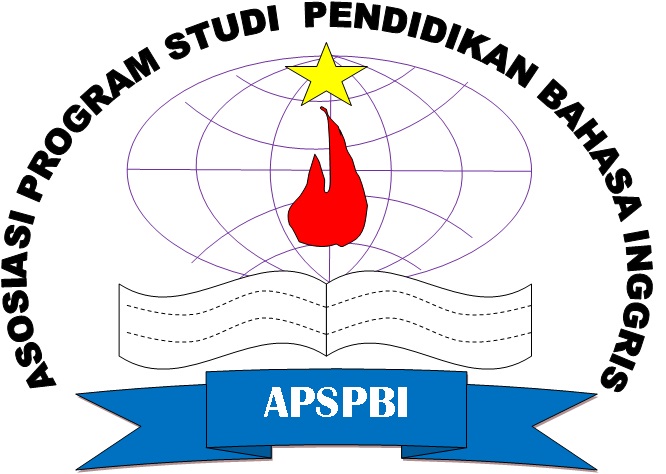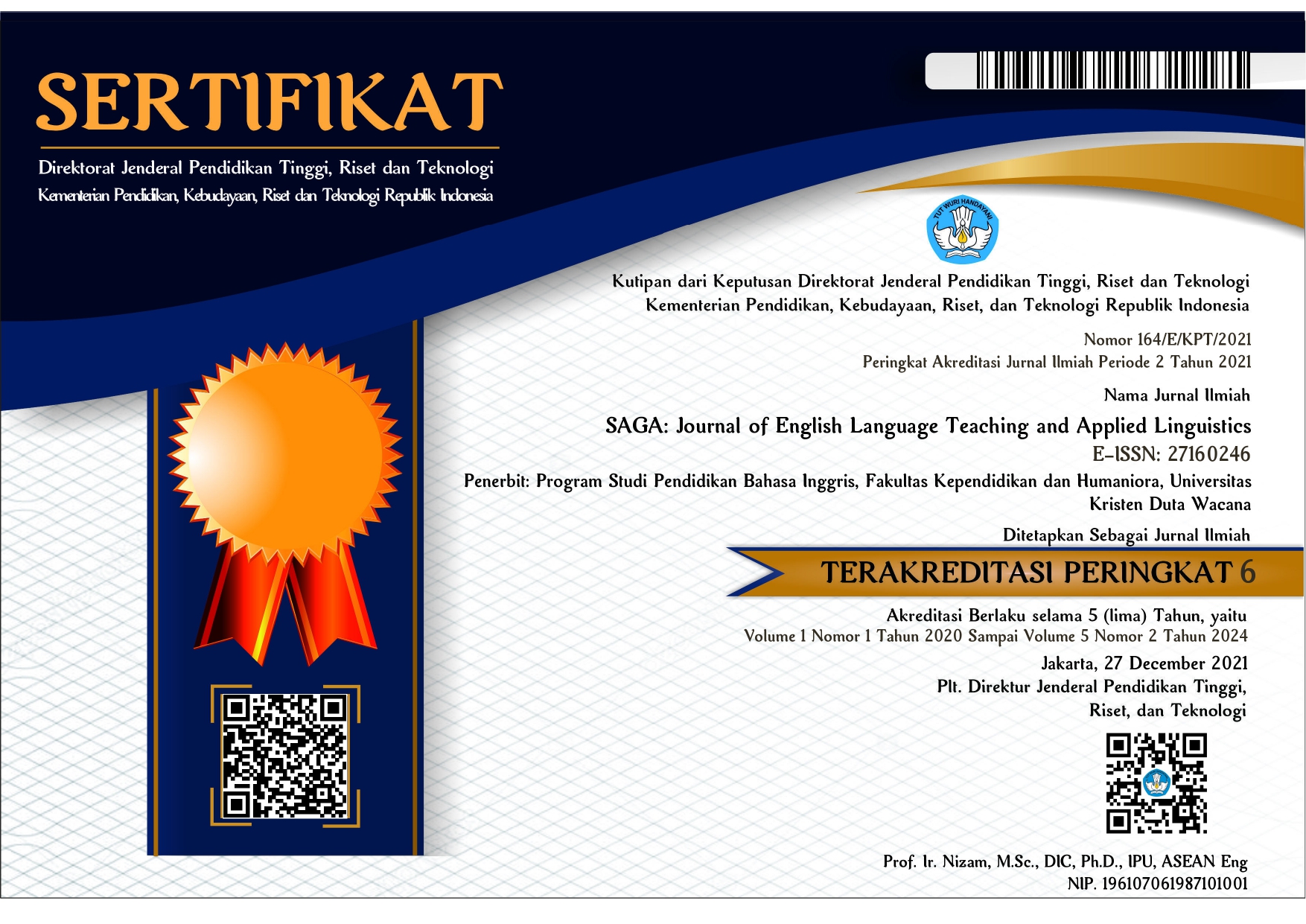Textbook Evaluation: How does It Assist Intercultural Communicative Competence?
DOI:
https://doi.org/10.21460/saga.2024.51.178Keywords:
cultural elements, textbook evaluation, intercultural communicative competenceAbstract
Language learning is culture-bound, so culture should be included in the process of language teaching and learning. Using the framework proposed by Cortazzi and Jin (1999), this study evaluates the potential use of the textbook English on Sky to assist Intercultural Communicative Competence in Instruction as evidenced by the occurrence of three types of cultural elements: source culture, target culture, and international culture contained in the textbook. Conducted in Islamic boarding school context, this descriptive study collected data through a checklist from Cortazzi and Jin (1999), questionnaires distributed to students, and an interview conducted to an English teacher using the textbook. The findings reveal that the textbook contains all types of cultural elements represented in reading texts, dialogues, pictures, and tasks. Even though the occurrence of each is not balanced, English on Sky has potential to assist Intercultural Communicative Competence in Instruction since all types of cultures contained do not conflict with the value of the Islamic context. Pedagogically, teachers can use the textbook as the main source for teaching materials in Islamic schools so that students’ Intercultural Communicative Competence can be enhanced.
References
Agustin, A., & Wirza, Y. (2020, November). Indonesian teachers’ perspective towards the use of authentic materials on students’ communicative competence in EFL classroom. In Proceedings of the 2020 4th International Symposium on Computer Science and Intelligent Control (pp. 1-5). https://doi.org/10.1145/3440084.3441215
Aliakbari, M. (2004). The place of culture in the Iranian ELT textbooks in high school level. The 9th Pan-Pacific Association of Applied Linguistics Conference. Seoul: Namseoul University
Al-Sofi, B. B. M. (2018). An evaluation of the cultural aspects in the university English textbook, Well Read 1. Theory and Practice in Language Studies, 8(2), 184-196. DOI: http://dx.doi.org/10.17507/tpls.0802.02
Ariawan, D. A., Nurkamto, J., & Sumardi, S. (2022). Critical discourse analysis of cultural representations in EFL national commercial textbooks. Studies in English Language and Education, 9(3), 1112-1127. https://doi.org/10.24815/siele.v9i3.24579
Arslan, S. (2016). An analysis of two Turkish EFL books in terms of cultural aspects. Procedia-Social and Behavioral Sciences, 232, 217-225. https://doi.org/10.1016/j.sbspro.2016.10.049
Brown, C. L. (2007). Strategies for making social studies texts more comprehensible for English-language learners. The Social Studies, 98(5), 185-188. https://doi.org/10.3200/TSSS.98.5.185-188
Byram, M. (1997). Teaching and assessing intercultural communicative competence. Multilingual Matters.
Byram, M., & Morgan, C. 1994. Teaching and learning language and culture. Multilingual Matters.
Celce-Murcia, M. (2008). Rethinking the role of communicative competence in language teaching. Intercultural language use and language learning. Springer.
Cogo, A. (2012). English as a lingua franca: Concepts, use, and implications. ELT journal, 66(1), 97-105. https://doi.org/10.1093/elt/ccr069
Cortazzi, M., & Jin, L. X. (1999). Cultural mirrors: materials and methods in the EFL classroom. In E. Hinkel (Ed.), Culture in second language teaching and learning (pp. 196-219). Cambridge University Press.
Creswell, J. W. (2014). Research design: Qualitative, quantitative, and mixed methods approach (4th ed.). SAGE.
Cunningsworth, A. (1995). Choosing your Coursebook. Heinemann.
Dahmardeh, M., & Kim, S. D. (2021). An analysis of the representation of cultural content in English coursebooks. Journal of Applied Research in Higher Education, 13(5), 1388-1407. https://doi.org/10.1108/JARHE-09-2020-0290
Fraenkel, J. R., Wallen, N. E., & Hyun, H. H. (2012). How to design and evaluate research in education. McGraw-Hill.
Graves, K., & Xu, S. (2000). Designing language courses: A guide for teachers. Heinle & Heinle.
Haycroft, J. (1998). An introduction To English language teaching. Longman.
Huda, M. (2019). Cultural contents of a junior high school English textbook when English rings a bell. A Thesis. Universitas Pendidikan Indonesia.
Juan, W. U. (2010). A content analysis of the cultural content in the EFL textbooks. Canadian Social Science, 6(5), 137-144.
Kilickaya, F. (2004). Guidelines to Evaluate Cultural Content in Textbooks. The Internet TESL Journal, 10(12), 1-5.
Lee, J. F., & Li, X. (2020). Cultural representation in English language textbooks: A comparison of textbooks used in mainland China and Hong Kong. Pedagogy, Culture & Society, 28(4), 605-623. https://doi.org/10.1080/14681366.2019.1681495
McGrath, I. (2002). Materials evaluation and design for language teaching. Edinburgh University Press.
McKay, S. L. (2003). Toward an appropriate EIL pedagogy: re-examining common ELT assumptions. International Journal of Applied Linguistics, 13(1), 1-22. https://doi.org/10.1111/1473-4192.00035
McKay, S. L., & Bokhorst-Heng, W. D. (2017). International English in its sociolinguistic contexts: Towards a socially sensitive EIL pedagogy. Routledge. https://doi.org/10.4324/9781315092553
O’Neill, R. (1982). Why use textbooks? ELT Journal, 36(2), 104-111. https://doi.org/10.1093/elt/36.2.104
Richards, J. C. (2001). The role of textbooks in a language program. RELC Guidelines, 23(2), 12-16.
Setyono, B., & Widodo, H. P. (2019). The representation of multicultural values in the Indonesian Ministry of Education and Culture-Endorsed EFL textbook: a critical discourse analysis. Intercultural Education, 30(4), 383-397. https://doi.org/10.1080/14675986.2019.1548102
Sheldon, L. E. (1988). Evaluating ELT textbooks and materials. ELT Journal, 42(4):237–46.
Silvia, A. (2015). The representation of culture in English textbooks prescribed for high schools in Indonesia. IJEE (Indonesian Journal of English Education), 2(1), 1-16. http://dx.doi.org/10.15408/ijee.v2i1.1432
Sugianto, A., & Wirza, Y. (2021). Cultural Contents of an EFL Textbook: How is the potential for students’ intercultural Communicative. Proceedings of the Thirteenth Conference on Applied Lingusitics (CONAPLIN)
Sulistiyo, U., Supiani, S., Kailani, A., & Lestariyana, R. P. D. (2020). Infusing moral content into primary school English textbooks: A critical discourse analysis. Indonesian Journal of Applied Linguistics, 10(1), 251-260.
Tedjasukmana, J. (2009). The way a literary agency deals with foreign rights. Unpublished material submitted to Det historisk- filosofiske fakultet Universitetet i Bergen.
Widdowson, H. G. (1998). Context, community, and authentic language. TESOL Quarterly, 32(4), 705-716. https://doi.org/10.2307/3588001
Xiang, R., & Yenika-Agbaw, V. (2021). EFL textbooks, culture and power: a critical content analysis of EFL textbooks for ethnic Mongols in China. Journal of multilingual and multicultural development, 42(4), 327-341. https://doi.org/10.1080/01434632.2019.1692024
Xiao, J. (2010). Cultural contents of an in-use EFL textbooks and English major students' attitude and perceptions towards culture Learning at Jiangxi University of Science and technology, China. Unpublished thesis submitted to the Graduate School Prince Songkla University.
Yansyah, F. (2017). Local and target language culture proportion in English textbooks “English on sky (EOS) 2” and “When English rings a bell (WERAB) VIII”. Edukasi: Jurnal Pendidikan Dan Pengajaran, 4(1), 11-23.
















